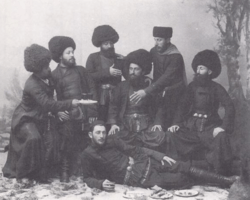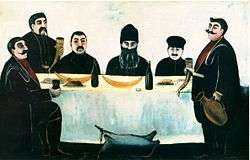Supra (feast)
A supra (Georgian: სუფრა [supʰra]) is a traditional Georgian feast and a part of Georgian social culture. There are two types of supra: a festive supra (ლხინის სუფრა, [lxinis supʰra]), called a keipi, and a sombre supra (ჭირის სუფრა, [tʃʼɪrɪs sʊpʰra]), called a kelekhi, that is always held after burials.

The traditions of supra, as an important part of Georgian social culture, were inscribed on the Intangible Cultural Heritage of Georgia list in 2017.[1][2]
Etymology
In Georgian, "supra" means "table-cloth". It's likely related to the Persian sofre (سفره), Arabic sufra (سفرة), Armenian sproc (սփրոց) and Turkish sofra, which are words for traditional eating surfaces. Large public meals are never held in Georgia without a supra; when there are no tables, the supra is laid on the ground.
Rules

Regardless of size and type, a supra is always led by a tamada, or toastmaster, who introduces each toast during the feast. The tamada is elected by the banqueting guests or chosen by the host. A successful tamada must possess great rhetorical skill and be able to consume a large amount of alcohol without showing signs of drunkenness.[3] During the meal, the tamada will propose a toast, and then speak at some length about the topic. The guests raise their glasses, but do not drink. After the tamada has spoken, the toast continues, often in a generally counter-clockwise direction (to the right). The next guest who wishes to speak raises their glass, holds forth, and then drains their glass. If a guest does not wish to speak, they may drink from their glass after some words that particularly resonate for him or her. Eating is entirely appropriate during toasts, but talking is frowned upon. Once everyone who wishes to speak on the theme has done so, the tamada proposes a new toast, and the cycle begins again. Some popular traditional themes include toasts to God, Georgia, family, the mother of God, various saints, friends, ancestors, and so on. However, the theme of each toast is up to the tamada, who should be able to tailor his or her toasts to the occasion.
A keipi toast is called sadghegrdzelo (სადღეგრძელო, [sadɣɛɡrdzɛlɔ]), while a kelekhi toast is called a shesandobari (შესანდობარი, [ʃɛsandɔbarɪ]).
See also
References
- "არამატერიალური კულტურული მემკვიდრეობა" [Intangible Cultural Heritage] (PDF) (in Georgian). National Agency for Cultural Heritage Preservation of Georgia. Retrieved 25 October 2017.
- "UNESCO Culture for development indicators for Georgia (Analytical and Technical Report)" (PDF). EU-Eastern Partnership Culture & Creativity Programme. October 2017. pp. 82–88. Retrieved 25 October 2017.
- "Sharing the same blood – culture and cuisine in the Republic of Georgia". Retrieved 2008-08-09.
External links
| Wikimedia Commons has media related to Supra. |
- Darra Goldstein, The Georgian Feast': The Vibrant Culture and Savory Food of the Republic of Georgia, 1999, ISBN 0-520-21929-5
- The Autocrat of the Banquet Table
- About Georgia